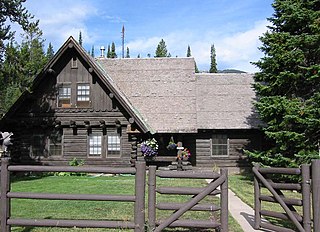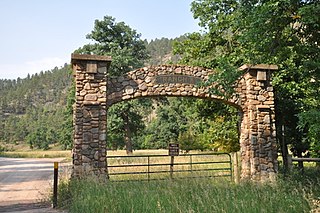The National Register of Historic Places (NRHP) is the United States federal government's official list of districts, sites, buildings, structures and objects deemed worthy of preservation for their historical significance or "great artistic value". A property listed in the National Register, or located within a National Register Historic District, may qualify for tax incentives derived from the total value of expenses incurred in preserving the property.
The Snake River Ranch, near Wilson, Wyoming, is the largest deeded ranch in the Jackson Hole area. The ranch buildings are grouped into three complexes comprising headquarters, residential and shop complexes. The ranch combined two neighboring homesteads and was first owned by advertising executive Stanley B. Resor and his wife, Helen Lansdowne Resor. The Resors used the property as a vacation home, but the ranch was also a full-time, self-sustaining operation.
The history of the National Register of Historic Places began in 1966 when the United States government passed the National Historic Preservation Act (NHPA), which created the National Register of Historic Places (NRHP). Upon its inception, the U.S. National Park Service (NPS) became the lead agency for the Register. The Register has continued to grow through two reorganizations, one in the 1970s and one in 1980s and in 1978 the NRHP was completely transferred away from the National Park Service, it was again transmitted to the NPS in 1981.

The Old Administrative Area Historic District, also known as Beaver Creek, is the former headquarters area of Grand Teton National Park. The complex of five houses, three warehouses and an administrative building were designed in the National Park Service rustic style between 1934 and 1939 and were built by the Civilian Conservation Corps and the Public Works Administration. As part of the Mission 66 program, the park headquarters were relocated to Moose, Wyoming in the 1960s.

The Andy Chambers Ranch is a historic district in Teton County, Wyoming, United States, that is listed on the National Register of Historic Places.

The AMK Ranch is a former personal retreat on the eastern shore of Jackson Lake in Grand Teton National Park. Also known as the Merymare, Lonetree and Mae-Lou Ranch, it was a former homestead, expanded beginning in the 1920s by William Louis Johnson, then further developed in the 1930s by Alfred Berol (Berolzheimer). Johnson built a lodge, barn and boathouse in 1927, while Berol added a larger lodge, new boathouse, and cabins, all in the rustic style.
The UXU Ranch is a historic dude ranch in Shoshone National Forest near Wapiti, Wyoming. The ranch began as a sawmill, as early as 1898. In 1929 Bronson Case "Bob" Rumsey obtained a permit from the U.S. Forest Service to operate a dude ranch on the property, using the sawmill headquarters building, a lodge, and tent cabins. Most of the current structures were built in the 1920s and 1930s from lumber milled on the site.

The TA Ranch was the site of the principal events of the Johnson County Range War in 1892. The TA was established in 1882 as one of the first ranches in Johnson County, Wyoming. The TA is the only intact site associated with the range war, with trenches used by both sides still visible and scars on the nearby buildings. The ranch also documents the expansion and development of cattle ranching in Wyoming.

The Rawhide Buttes Stage Station, the Running Water Stage Station and the Cheyenne-Black Hills Stage Route comprise a historic district that commemorates the stage coach route between Cheyenne, Wyoming and Deadwood, South Dakota. The route operated beginning in 1876, during the height of the Black Hills Gold Rush, and was replaced in 1887 by a railroad.
The HF Bar Ranch is located in Johnson County, Wyoming about 20 miles (32 km) northwest of Buffalo, Wyoming in the foothills of the Bighorn Mountains near Saddlestring, Wyoming. The ranch is a working cattle ranch comprising about 36 buildings, built between 1898 and 1921. The ranch is associated with Wyoming state senator and U.S. Congressman Frank O. Horton, who purchased it in 1911 with financial help from his investment banker brother-in-law and sister-in-law, Warren and Demia Gorrell. The Gorrells and their children spent summers in Wyoming, while the Hortons stayed year-round.
History Colorado is a historical society that was established in 1879 as the State Historical Society of Colorado, also known as the Colorado Historical Society. History Colorado is a 501(c)(3) organization and an agency of the State of Colorado under the Department of Higher Education.
The Sommers Ranch Headquarters Historic District is a historic ranch complex located southwest of Pinedale, Wyoming. The district includes 11 wooden buildings, including a homestead house, a bunkhouse, a barn, and various other farm buildings and outbuildings. Albert P. "Prof" Sommers founded the ranch in 1908. Sommers married May McAlister in 1911; after the couple bought land from May's parents and her friend Nellie Yates, their ranch grew to 1,900 acres (770 ha). The ranch is still operational and serves as an example of the many ranches built in the upper Green River Valley.

Ranch A, near Beulah, Wyoming, was built as a vacation retreat for newspaper publisher Moses Annenberg. The original log ranch structures in Sand Creek Canyon were designed in the rustic style by architect Ray Ewing. The principal building, a large log lodge, was built in 1932. Other buildings constructed at the time included a garage with an upstairs apartment, a barn, a hydroelectric power plant, stone entrance arches and a pump house. The lodge was furnished with Western furniture and light fixtures made by noted designer Thomas C. Molesworth. Many of these furnishings, among the first of Molesworth's career, are now the property of the state of Wyoming and are in the Wyoming State Museum.

The historical buildings and structures of Grand Teton National Park include a variety of buildings and built remains that pre-date the establishment of Grand Teton National Park, together with facilities built by the National Park Service to serve park visitors. Many of these places and structures have been placed on the National Register of Historic Places. The pre-Park Service structures include homestead cabins from the earliest settlement of Jackson Hole, working ranches that once covered the valley floor, and dude ranches or guest ranches that catered to the tourist trade that grew up in the 1920s and 1930s, before the park was expanded to encompass nearly all of Jackson Hole. Many of these were incorporated into the park to serve as Park Service personnel housing, or were razed to restore the landscape to a natural appearance. Others continued to function as inholdings under a life estate in which their former owners could continue to use and occupy the property until their death. Other buildings, built in the mountains after the initial establishment of the park in 1929, or in the valley after the park was expanded in 1950, were built by the Park Service to serve park visitors, frequently employing the National Park Service Rustic style of design.

The M L Ranch was established by Henry Clay Lovell and his financial backer Anthony Mason in Wyoming's Big Horn Basin in the late 1870s to the south of the present location. The second and final location was established farther north as a cattle line camp in 1883 to be closer to markets in Billings, Montana. In 1884 it became the headquarters for a ranch that reached 25,000 acres (10,000 ha) in area. The bad winter of 1886–87 killed half the livestock on the ranch, more than 10,000 head., but the M L fared better than most. Mason died in 1892. Lovell died in Oregon in 1903. Lovell, Wyoming was named in his memory. The Lovell family ran the ranch until 1909. In the early 1960s the ranch was purchased by the Bureau of Reclamation as part of the Bighorn Lake reservoir project. In 1966 the headquarters site was transferred to the National Park Service as part of Bighorn Canyon National Recreation Area.

The F.S. King Brothers Ranch Historical District is located in the hills northeast of Laramie, Wyoming.
The Beaver Creek Ranch Headquarters, in the vicinity of Buffalo in the Powder River Basin in Johnson County, Wyoming, was listed on the National Register of Historic Places in 2014. The ranch has been known as Schoonover Ranch, as Harriet Ranch, and as Iberlin Ranch.

Medicine Lodge State Archeological Site is a Wyoming state park that interprets the Medicine Lodge Creek Site, a prehistoric Native American archeological site near Hyattville, Wyoming. It is administered by the Wyoming Division of State Parks and Historic Sites. The site is at the base of a steep limestone outcropping near the point where the dry and running portions of Medicine Lodge Creek join. for a protected location with ready access to water. The site includes petroglyphs and pictographs on the rock face. Excavations starting in the 1970s have found twelve levels of habitation in 10.5 feet of stratum, ranging from historic times to 8300 years before the present. The site comprises a portion of the former Wickwire Ranch, which was purchased by the state in 1972 and became to Medicine Lodge Wildlife Habitat Management Area of 12,000 acres (4,900 ha). The archeological site was designated in 1973. The site is managed as a state park, with campgrounds and a visitor center. It was added to the National Register of Historic Places on July 5, 1973.
The Dorr Ranch was established by William and Mabel Dorr in 1910 in Converse County, Wyoming along Woody Creek. William had left home at the age of 8 or 9 and worked for the 71 Quarter Ranch and as a horse wrangler at Pony Express stations in Wyoming. He met Mabel McIntosh and married her in 1904. Mabel's parents had established the successful Hat Ranch near Split Rock and had significant resources to assist the young couple. The Dorrs filed for their first homestead in 1910 and expanded it in 1915, and again in 1917 and 1919, with a separate 1919 filing by Mabel. The Dorr's properties were not contiguous, and the present ranch house on Woody Creek was not built until 1915. In 1919 the Dorr School was built on the ranch. The same year the community of Bill was established, named after the shared name of four of the founders. The main ranch house was built in 1926–27.
The Huxtable Ranch Ranch Headquarters District, also known as White Creek Ranch, comprises a complex of ranch structures in Converse County, Wyoming. It was part of a dispersed community known as Boxelder, established by settlers in the 1880s. The ranch was established in 1893 by Charles Smith who built a one-room and later a three-room cabin on the property, as well as a barn. Three years later he sold the homestead to Willard Heber White. White and his wife lived on the ranch until 1928 when they moved to Douglas. On White's death in 1929, the ranch was purchased by Lloyd Huxtable and Charlie Olin. Lloyd and Olin built the present ranch house for Charlie and his wife Najima, Olin's sister, from 1933 to 1935. The Huxtables operated the ranch until his death at 86 in 1976. Huxtable served as a Converse County Commissioner from 1948 to 1956.











